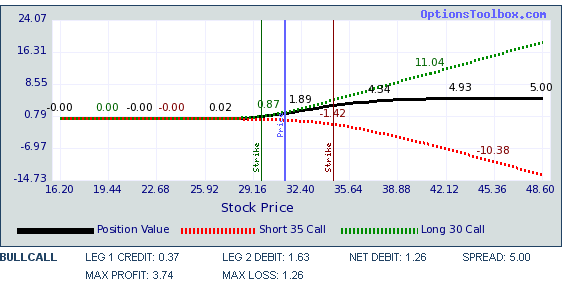About Option Spreads
Spreads consist of two option legs. Both legs are calls or both legs are puts, and one leg is long while the other is short. Spreads are either bearish or bullish. The underlying stock must move in a particular direction in order for the spread to be profitable. The difference between trading a stock and trading a spread is that losses can be limited with a spread. It is possible to make large gains on small movements or no movement in the underlying security with minimal cash outlays and limited risk.
|
Vertical Spreads |
|||
|---|---|---|---|
| Trade Type | Sentiment | Debit/Credit | Short Leg |
| Bull Call | Bullish | Net Debit | OTM Call |
| Bear Call | Bearish | Net Credit | ITM Call |
| Bull Put | Bullish | Net Credit | ITM Put |
| Bear Put | Bearish | Net Debit | OTM Put |
A horizontal spread, also known as a calendar spread. consists of two legs that have the same strike price but have different expiration dates. The short leg is the option with the shorter term, since the rate of time decay (theta), is more rapid. The short leg is rolled forward at or near expiration by selling the next month's option at the same strike, or the position is closed by selling the longer term leg when the short term leg expires.
A diagonal spread consists of two legs that have different strikes and different expirations. The objective of a diagonal spread can vary. They may be traded to capitalize on time decay or discrepancies in volatility, they may be used to roll out of other positions such as straddles, and they may be part of more complex strategies such as butterflies or collars
What Makes a Good Spread?
One objective of trading spreads is to capitalize on the difference in premium between two option contracts. A spread trader may be looking to collect time premium by selling the expensive leg of a spread, and buying the cheaper leg to limit loss. The expensiveness of an option correlates to the time premium of an option. Time value is not measured in absolute dollars, it is the cost of the option attributable to a number of factors including implied volatility.
Spread trades have a greater potential for profit when the time value on the short leg is greater than the time value on the leg that is purchased. At Optionistics, the spread screeners rank the amount of time premium by computing the implied volatility of the option legs, then finds the spreads where the time premium is greater on the short leg than the long leg.
Spreads Identified by the Option Screeners
A good spread, whether vertical, horizontal, or diagonal, is characterized by having higher premium on the short leg. Over time, the value of the short leg will degrade more rapidly than the long leg, increasing the potential for profit.
The complex option screeners identify spreads that have higher premium on the short leg versus the long leg. Trades are not selected by the screeners based on the probability of the underlying stock going up or down. For example, if a trade appears on the bull call report it does appear there because it is more likely that the underlying stock will go up. If the underlying stock goes up, the trades on the bull call screener will potentially be more profitable than other similar complex option trades for that stock. Once you have determined the likely direction of stock movement, the complex option report can be run against the desired underlying stock symbol.

Another criteria for desirable spreads is to find trades where the amount of money that can be gained from the spread is greater than the amount at risk. The Bull Call illustrated to the right has a net debit of $1.26. This is the cost to enter the spread and is the maximum that can be lost. The spread, which is the difference between the strikes, is the maximum value the spread can ever have. Therefore, the maximum profit is $3.74 (spread - debit) and the maximum loss is $1.26. If, on average, half of these types of trades are profitable, then the overall strategy of trading these types of debit spreads will also be profitable.
The Spread Screeners examine combinations of options that may comprise spreads based on a purely technical analysis of pricing data, without consideration of the underlying stock's soundness or other market conditions. The screeners help narrow your choice of stocks to research, but using them should be only one of many steps taken before entering a position.

